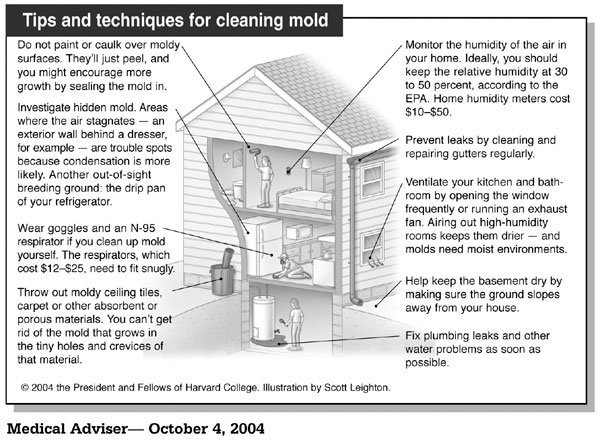By the faculty of Harvard Medical School
Q: My family’s home has always been prone to mold. Our finished
basement is often damp, and the bathroom tiles become dirty with
mold growth soon after cleaning. I’ve read a couple of articles on
mold being toxic, but we’ve never noticed problems. Should we do
something about our mold problem?
By the faculty of Harvard Medical School
Q: My family’s home has always been prone to mold. Our finished basement is often damp, and the bathroom tiles become dirty with mold growth soon after cleaning. I’ve read a couple of articles on mold being toxic, but we’ve never noticed problems. Should we do something about our mold problem?
A: Fear of “toxic mold” began after federal health officials blamed household mold for a cluster of 10 cases of pulmonary hemorrhage (bleeding in the lungs) in Cleveland. But the report was later retracted when outside reviewers found serious mistakes in the investigation. Most experts say there’s more fear than fact to “toxic mold,” but they warn that indoor mold can cause health problems among some.
Our abodes make great homes for mold. Moisture is trapped in homes easily, and mold’s main food source, cellulose, is found in many common building materials: wood, paper and wallboard. With a combination of water and food, mold is happy enough growing anywhere and is commonly found in basements, bathrooms and other damp, dark places.
Some molds do produce chemicals that are toxic to people. These chemicals are known as mycotoxins. (“Myco” means anything having to do with fungi.) In the 1940s, thousands of Russians got sick from eating mold-contaminated corn and wheat that had been stored under snow during the winter.
So, mold grows indoors, and some molds produce toxins: Does this mean the mold in your basement is toxic? It’s hard to say. Many lab and animal tests have shown that common household molds produce chemicals with a variety of toxic effects. But the amounts and types of these chemicals vary greatly. Temperature, moisture, the food source and competition from other organisms all play a role. Just because a mold produces a toxin in a lab doesn’t mean it is doing so in your home.
Some scientists wonder how many people are actually exposed to these toxins in the home. Clearly, people aren’t eating moldy wallboard. So the question becomes whether these molds put enough of their toxins in the air so that people get sick from breathing them in. Here is where you run into some sharp differences of opinion.
Some experts point out that these toxic molecules are heavy, and don’t float through the air easily, making it hard for people to inhale them. For other experts, the fact that tests have detected mold-generated toxins is concern enough. The bottom line is that indoor mold might have toxic effects, but most experts believe it’s highly unlikely.
Mold spores – the hardy reproductive cells released by molds and other fungi – are another possible source of exposure to airborne mold toxins. Although the evidence is limited, the spores of some molds do contain toxins, but in tiny amounts (millionths of a gram in every million spores).
Skeptics argue that the indoor air would have to be thick with mold spores for there to be enough spore-contained toxins to make people sick. Hay fever sufferers know that high spore counts are possible. Outdoor air counts in August can reach 10,000 spores per cubic meter. But whether indoor molds produce such high concentrations is doubtful.
There is good evidence, however, that indoor mold plays a role in allergy and asthma. Mold spores contain the allergens that cause allergic reactions. Allergies can trigger asthma, a condition in which airways get inflamed and constricted. Asthma rates have soared in American cities, and federal housing officials are funding studies to see if cleaning up mold in homes can slow down or reverse that trend.
Perhaps fear of toxic mold is overblown, but that doesn’t mean you should ignore the significance of the other health consequences.
If you would like to e-mail questions to the Harvard Medical School Adviser, you can submit questions to the Harvard Medical School Adviser at www.health.harvard.edu/adviser.













